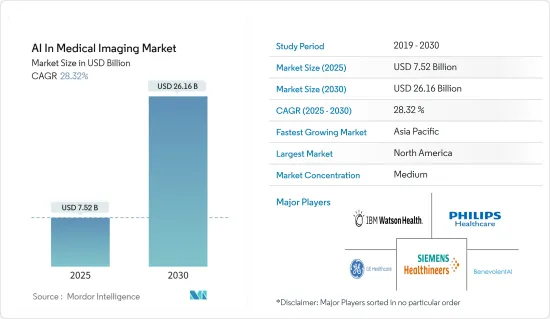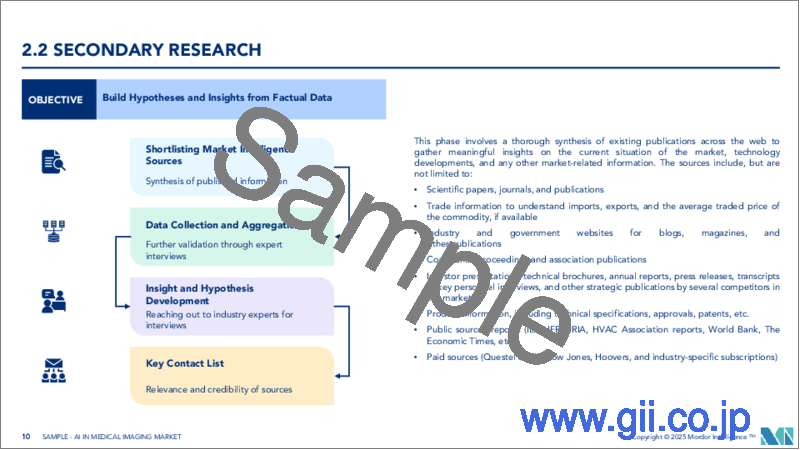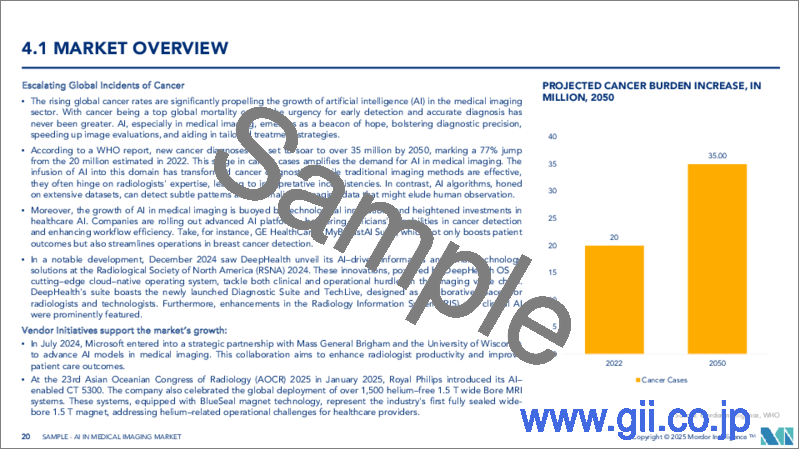|
|
市場調査レポート
商品コード
1643096
医用画像におけるAI:市場シェア分析、産業動向と統計、成長予測(2025年~2030年)AI In Medical Imaging - Market Share Analysis, Industry Trends & Statistics, Growth Forecasts (2025 - 2030) |
||||||
カスタマイズ可能
適宜更新あり
|
|||||||
| 医用画像におけるAI:市場シェア分析、産業動向と統計、成長予測(2025年~2030年) |
|
出版日: 2025年01月05日
発行: Mordor Intelligence
ページ情報: 英文 120 Pages
納期: 2~3営業日
|
全表示
- 概要
- 目次
医用画像におけるAIの市場規模は2025年に75億2,000万米ドルと推定され、予測期間(2025-2030年)のCAGRは28.32%で、2030年には261億6,000万米ドルに達すると予測されます。

主なハイライト
- 高齢化の進展は、ヘルスケアエコシステムへの投資の増加と相まって、予測期間中の市場全体の成長にプラスの影響を与えると予想されます。新興国市場はこの人口動態の課題に直面しており、人々に安価で先進的なヘルスケアシステムを提供するために投資を行っています。さらに、コンピュータ断層撮影(CT)スキャンは、X線検査では検出されない肺の小さな病変を検出することができます。医療分野におけるX線の用途は、確認用、診断用、補助用とさまざまです。
- 医療技術革新の最も有望な分野の1つは、画像処理と判読を含むがこれに限定されない、医用画像における人工知能(AI)の応用です。医用画像におけるAIは、検出時間を短縮するだけでなく、検出精度を高め、健康問題を時間通りに診断するのに役立ちます。例えば、マウントサイナイ病院の研究者は、出血プロトコルを駆動するためにGauss Surgical社のTritonを使用し、帝王切開と経膣分娩の両方で出血の認識を2~4倍に増加させ、出血を制御するための遅延介入を34%削減し、不必要な輸血や臨床検査から209,000米ドルの年間コストを回避しました。
- 人工知能(AI)、特に機械学習(ML)として知られるAIのサブセットを組み込んだソフトウェアは、ヘルスケアのあらゆる面で技術が進歩するにつれて、いくつかの医療機器のますます重要な機能となっています。機械学習の最も大きな利点の一つは、ヘルスケアを提供する際に日々収集される膨大な量のデータから、新たな価値ある洞察を引き出す能力です。
- 人工知能(AI)、特に機械学習(ML)として知られるAIのサブセットを組み込んだソフトウェアは、ヘルスケアのあらゆる面で技術が進歩するにつれて、いくつかの医療機器のますます重要な機能となっています。機械学習の最も重要な利点の一つは、ヘルスケアを提供する際に毎日収集される膨大な量のデータから、新たな価値ある洞察を引き出す能力です。
医用画像における人工知能(AI)市場動向
コンピュータ断層撮影が市場成長を牽引する見込み
- コンピュータ断層撮影(CT)市場の成長の主な要因としては、がんや心血管疾患など、生活習慣に関連するさまざまな慢性疾患の有病率の増加、AIと統合された高度な画像ソリューションに対する需要の増加、AI対応ソリューションへのさらなる投資などが挙げられ、市場全体の成長を牽引すると期待されています。救急部における高度な評価ツールに対する需要の増加や、外来救急治療室の増加は、CT市場の成長にプラスの影響を与えると予想される要因であり、医用画像におけるAI市場の需要全体を押し上げます。
- 低線量CT処置に起因する画像ノイズは、画像サービスの品質、効率、コストに悪影響を連鎖的に及ぼします。AIベースのDLRと後処理技術は、数秒でCT画像を処理することができ、IRよりもはるかに幅広い線量と検査タイプで画像ノイズを低減することができます。
- 米国がん協会によると、米国では今年、合計236,740人の肺がんおよび気管支がんの新規患者が発生すると推定されています。さらに、CTスキャンは肺腫瘍の形、大きさ、正確な位置を示すのに役立ち、病気の徴候や症状がなくても肺がんを開発する危険性がある場合にも役立ちます。
- コンピュータ断層撮影(CT)では、AIは、患者の位置決めや撮影パラメータ設定を含むデータ収集プロセスの自動化と最適化を通じて、患者の被曝線量のさらなる低減を可能にすることが期待されています。同市場のプレーヤーは、調査対象市場におけるCTスキャンのニーズの高まりに対応するため、進歩を導入しています。例えば、2022年8月、Xoran Technologies社は、真に移動可能な全身透視CT(コンピュータ断層撮影)X線システムであるTRONのFDA 510(k)認可を取得したと発表しました。TRONは、手術室、手術センター、重症患者治療室などの従来の環境において、安全で超高解像度の低線量撮影を提供するように設計されています。
アジア太平洋地域が最も高い成長を遂げる
- アジア太平洋地域では、製薬・バイオテクノロジー分野における研究開発費の増加や開発の進展により、ヘルスケアにおける人工知能が予測期間中に有利な成長を遂げることが期待されています。
- さらに、多くの患者が存在することで、より良いヘルスケアサービスへの需要が高まり、ヘルスケアインフラが整備され、可処分所得が増加し、この地域における医用画像におけるAIの成長をさらに後押しします。さらに、ヘルスケア分野への支出も増加しています。新興経済諸国は、患者の診断と治療のための強固なヘルスケア・インフラの開発にますます注力しています。インベスト・インディアによると、インドの病院部門はヘルスケア市場全体の80%を占めており、国内外の投資家から大きな関心が寄せられています。
- さらに、AI医療画像処理は、中国のヘルスケア業界で最も一般的なAIアプリケーションの1つです。現在、中国におけるAI医療アプリケーションの市場セグメントの中で2番目に大きく、2024年には40%以上の成長率を記録し、25億米ドルの規模に達すると予測されています。中国では医療画像診断の専門医の数にかなりの開きがあります。中国では医療画像のデータセットが毎年30%増加しており、病院のデジタルデータ量の90%を占めています。一方、放射線科医の数は年間4%しか増加していないです。中国におけるAI医用画像は、業界関係者の間では、中国のヘルスケア産業でAIを商用化する最初の市場と考えられています。
- COVID-19の普及は、医療技術関連企業に機器の商業生産への迅速な移行を促しています。通常の状況下では、企業は顧客へのアプローチなどの活動を中心に行っています。急激な受診需要の高まりの中、オンライン病院、AIによる検温、遠隔診療、インターネットによるドラッグデリバリーなど、新たなサービスが急速に実用化に向かっています。
- COVID-19は、この地域の医療業界に多くの認識をもたらしました。ロイヤル・フィリップスが発表した新しい放射線科業界調査によると、シンガポール、オーストラリア、韓国の放射線科医10人中8人(80%)が、人工知能(AI)が現在の臨床ワークフローに組み込まれ、より確実な診断とデータ処理が可能になると期待されていると考えています。
医用画像における人工知能(AI)産業の概要
医療用画像診断におけるAI市場は、国内外に多くのプレーヤーが存在するため、競争は中程度です。同市場はより結束している可能性があります。医療画像市場におけるAIアプリケーションの増加により、主要企業は製品革新、提携、合併、買収などの戦略を採用しています。
2022年7月、シーメンス・ヘルティニアーズが提供する磁気共鳴画像(MRI)機能は、人工知能(AI)によって加速され、強化されます。スキャン時間、解像度、画像ノイズの妥協がMR画像の品質を決定します。ノイズを最小限に抑え、正確な答えを維持するか画質を向上させることで、医師は大幅に短いスキャン時間を選択することができます。Deep Resolveは、最終的な診断画像のみを向上させるのではなく、かなり早い段階から開始する:スキャナーからの生データを使った画像再構成の初期段階から、AIアルゴリズムを使って画像を改善します。
2022年7月、臨床結果、放射線治療の効率、企業の効率に革命をもたらす人工知能(AI)&デジタルソリューションとともに、同社は患者ケアを改善するための最先端イメージング技術を展示しました。GEヘルスケアは、旧世代のGE CTスキャナーと比較してボア内の患者エリアを22%拡大するため、Revolution Ascend CTシステムをECR 2022で発表しました。このシステムは、75センチ幅の新しいガントリ設計と低いテーブル位置を組み合わせたものです。
その他の特典:
- エクセル形式の市場予測(ME)シート
- 3ヶ月間のアナリストサポート
目次
第1章 イントロダクション
- 調査の前提条件と市場定義
- 調査範囲
第2章 調査手法
第3章 エグゼクティブサマリー
第4章 市場洞察
- 市場概要
- 産業バリューチェーン分析
- 業界の魅力度-ポーターのファイブフォース分析
- 供給企業の交渉力
- 買い手/消費者の交渉力
- 新規参入業者の脅威
- 代替品の脅威
- 競争企業間の敵対関係
- 技術別スナップショット
- ディープラーニング
- コンピュータビジョン
- 自然言語処理
- その他の技術
- 産業バリューチェーン分析
- COVID-19:医療用画像処理におけるAI市場への影響
- 市場促進要因
- 画像処理量の増加
- 市場の課題
- 高コストとシステム導入の難易度
第5章 市場セグメンテーション
- 製品別
- ソフトウェアツール/プラットフォーム
- サービス
- 画像取得技術別
- X線
- コンピュータ断層撮影
- 磁気共鳴イメージング
- 超音波イメージング
- 分子イメージング
- エンドユーザー別
- 病院
- クリニック
- 研究所・診断センター
- その他のエンドユーザー
- 地域別
- 北米
- 米国
- カナダ
- 欧州
- ドイツ
- フランス
- 英国
- その他欧州
- アジア太平洋
- インド
- 中国
- 日本
- その他アジア太平洋地域
- 世界のその他の地域
- 北米
第6章 競合情勢
- 企業プロファイル
- Siemens Healthineers AG
- GE Healthcare
- IBM Watson Health
- BenevolentAI Limited
- Philips Healthcare
- Zebra Medical Vision Inc.
- Samsung Electronics Co. Ltd
- Medtronic Plc
- EchoNous, Inc.
- Enlitic Inc.
- Nvidia Corporation
- Oxipit.ai
第7章 投資分析
第8章 市場機会と今後の動向
The AI In Medical Imaging Market size is estimated at USD 7.52 billion in 2025, and is expected to reach USD 26.16 billion by 2030, at a CAGR of 28.32% during the forecast period (2025-2030).

Key Highlights
- The growing aging population, coupled with rising investment in the healthcare ecosystem, is expected to impact overall market growth over the forecast period positively. Developed nations have been facing this demographic challenge and have been investing in bringing affordable and advanced healthcare systems to the people, thereby providing impetus to the market. Additionally, a computed tomography (CT) scan can detect small lesions in the lungs that go undetected on an X-ray. Confirmative, diagnostic, and supportive are different uses of X-rays in the medical domain.
- One of the most promising areas of health innovation is the application of artificial intelligence (AI) in medical imaging, including, but not limited to, image processing and interpretation. AI in medical imaging not only reduces the time of detection but also increases the accuracy of detection and helps diagnose health issues on time. For instance, researchers at the Mount Sinai Hospital used Triton from Gauss Surgical to drive hemorrhage protocols, leading to a 2-4 times increase in hemorrhage recognition in both c-sections and vaginal deliveries, a 34% reduction in delayed interventions to control bleeding, and USD 209,000 annualized cost avoidance from unnecessary transfusions and lab tests.
- Software incorporating artificial intelligence (AI), particularly the subset of AI known as machine learning (ML), has become an increasingly significant feature of several medical devices as technology advances in every aspect of healthcare. One of the most significant benefits of machine learning is its ability to extract new and valuable insights from the massive amounts of data gathered every day when providing healthcare.
- Software incorporating artificial intelligence (AI), particularly the subset of AI known as machine learning (ML), has become an increasingly significant feature of several medical devices as technology advances in every aspect of healthcare. One of the most significant benefits of machine learning is its ability to extract new and valuable insights from the massive amounts of data gathered every day when providing healthcare.
Artificial Intelligence (AI) in Medical Imaging Market Trends
Computed Tomography is Expected to Drive the Market Growth
- The major factors for the growth of the computed tomography (CT) market include the growing prevalence of various lifestyle-associated chronic diseases such as cancer and cardiovascular conditions and increasing demand for advanced imaging solutions integrated with AI and further investment in AI-enabled solutions are some of the factors expected to drive the overall market growth. Increasing demand for advanced assessment tools in the emergency department and a growing number of ambulatory emergency care units are the drivers expected to positively impact the CT market growth, which will boost the overall demand for the AI market in medical imaging.
- Image noise resulting from low-dose CT procedures causes a negative cascading effect on the quality, efficiency, and cost of imaging services. AI-based DLR and post-processing techniques are able to process CT images in a matter of seconds - to reduce image noise across a much broader range of doses and exam types than IR.
- According to the American Cancer Society, a total of 236,740 new cases of lung and bronchus cancer are estimated this year in the United States. Furthermore, a CT scan can help in showing the shape, size, and accurate position of any lung tumor and can even help in cases where there is a risk of developing lung cancer without the individual seeing any signs or symptoms of the disease.
- In computed tomography (CT), AI holds the promise of enabling further reductions in patient radiation dose through automation and optimization of data acquisition processes, including patient positioning and acquisition parameter settings. The players in the market are introducing advancements to cater to the rising need for CT scans in the studied market. For instance, in August 2022, Xoran Technologies announced that it received FDA 510(k) clearance for TRON, a truly mobile, full-body fluoroscopy, computed tomography (CT.) X-ray system. It is designed to provide safe, ultra-high-resolution, low-dose imaging in traditional settings such as the operating room, surgery center, and critical care unit.
Asia-Pacific to Witness Highest Growth
- In the Asia-Pacific, artificial intelligence in healthcare is expected to witness lucrative growth over the forecast period, owing to rising R&D expenditure and developments in the pharmaceutical and biotechnology sectors.
- Additionally, the presence of a significant patient pool will trigger demand for better healthcare services, develop healthcare infrastructure, and increase disposable income to support further the growth of AI in Medical Imaging in the region. Furthermore, spending in the healthcare sector gained heightened traction. Economies in the region are increasingly concentrating on developing a robust healthcare infrastructure for patient diagnoses and treatment. According to Invest India, India's hospital sector, accounting for 80% of the total healthcare market, is observing significant investor interest from both global and domestic investors.
- Furthermore, AI medical imaging is one of the most common AI applications in the healthcare industry in China. It is currently the second-largest market segment of AI medical applications in China and was predicted to witness a growth rate of more than 40% and reach a scale of USD 2.5 billion in 2024. There is a considerable gap in the number of professional doctors in medical imaging in China. The medical imaging dataset increases by 30% every year in China, which also accounts for 90% of the digital data volume for a hospital. In contrast, the number of radiologists increases by only 4% a year. AI medical imaging in China is considered by industry insiders to be the first market to commercialize AI in the healthcare industry in China.
- The spread of COVID-19 has urged medical technology-related companies to shift to commercial production of equipment rapidly. Under normal conditions, companies are centering on activities such as approaching customers. Amid the abrupt increase in demand for medical examinations, new services such as online hospitals, temperature checks by AI, remote medical care, and delivery of drugs via the Internet are rapidly moving toward practical use.
- COVID-19 has brought a lot of awareness to the medical industry in the region. According to a new radiology industry study released by Royal Philips, eight out of ten radiologists in Singapore, Australia, and South Korea (80%) believed that artificial intelligence (AI) is expected to be integrated into their current clinical workflow, enabling more confident diagnosis and data processing.
Artificial Intelligence (AI) in Medical Imaging Industry Overview
The AI Market in Medical Imaging is moderately competitive, owing to the presence of many players in the market operating in the domestic and international markets. The market could be more cohesive. Due to the increase in AI applications in the medical imaging market, major players are adopting strategies like product innovation, partnerships, mergers, and acquisitions.
In July 2022, the Magnetic Resonance Imaging (MRI) capabilities offered by Siemens Healthineers are accelerated and enhanced by artificial intelligence (AI). The compromise between scan time, resolution, and picture noise determines the MR imaging's quality. Minimizing noise and maintaining the exact answer or improving picture quality allows doctors to select a substantially shorter scan time. Instead of only enhancing the final diagnostic picture, Deep Resolve begins considerably earlier: It uses AI algorithms to improve the image from the initial stages of image reconstruction using the raw data from the scanner.
In July 2022, along with its artificial intelligence (AI) & digital solutions that seek to revolutionize clinical results, radiology efficiency, and enterprise efficiency, the company showcased its cutting-edge imaging technologies for improving patient care. To enhance the patient area within the bore by 22% compared to earlier generations of GE CT scanners, GE Healthcare unveiled the Revolution Ascend CT system at ECR 2022. This system combines a new 75-centimeter-wide gantry design with a lower table position.
Additional Benefits:
- The market estimate (ME) sheet in Excel format
- 3 months of analyst support
TABLE OF CONTENTS
1 INTRODUCTION
- 1.1 Study Assumptions and Market Definition
- 1.2 Scope of the Study
2 RESEARCH METHODOLOGY
3 EXECUTIVE SUMMARY
4 MARKET INSIGHTS
- 4.1 Market Overview
- 4.2 Industry Value Chain Analysis
- 4.3 Industry Attractiveness - Porter's Five Forces Analysis
- 4.3.1 Bargaining Power of Suppliers
- 4.3.2 Bargaining Power of Buyers/Consumers
- 4.3.3 Threat of New Entrants
- 4.3.4 Threat of Substitutes
- 4.3.5 Intensity of Competitive Rivalry
- 4.4 Technology Snapshot - By Technology
- 4.4.1 Deep Learning
- 4.4.2 Computer Vision
- 4.4.3 Natural Language Processing
- 4.4.4 Other Technologies
- 4.5 Industry Value Chain Analysis
- 4.6 COVID-19 Influence on the AI Market in Medical Imaging
- 4.7 Market Drivers
- 4.7.1 Increasing Imaging Volumes
- 4.8 Market Challenges
- 4.8.1 High Cost and Reluctance of Adoption of These Systems
5 MARKET SEGMENTATION
- 5.1 By Offering
- 5.1.1 Software Tools/Platform
- 5.1.2 Services
- 5.2 By Image Acquisition Technology
- 5.2.1 X-Ray
- 5.2.2 Computed Tomography
- 5.2.3 Magnetic Resonance Imaging
- 5.2.4 Ultrasound Imaging
- 5.2.5 Molecular Imaging
- 5.3 By End User
- 5.3.1 Hospitals
- 5.3.2 Clinics
- 5.3.3 Research Laboratories & Diagnostic Centers
- 5.3.4 Other End Users
- 5.4 By Geography
- 5.4.1 North America
- 5.4.1.1 United States
- 5.4.1.2 Canada
- 5.4.2 Europe
- 5.4.2.1 Germany
- 5.4.2.2 France
- 5.4.2.3 United Kingdom
- 5.4.2.4 Rest of Europe
- 5.4.3 Asia Pacific
- 5.4.3.1 India
- 5.4.3.2 China
- 5.4.3.3 Japan
- 5.4.3.4 Rest of Asia Pacific
- 5.4.4 Rest of the World
- 5.4.1 North America
6 COMPETITIVE LANDSCAPE
- 6.1 Company Profiles
- 6.1.1 Siemens Healthineers AG
- 6.1.2 GE Healthcare
- 6.1.3 IBM Watson Health
- 6.1.4 BenevolentAI Limited
- 6.1.5 Philips Healthcare
- 6.1.6 Zebra Medical Vision Inc.
- 6.1.7 Samsung Electronics Co. Ltd
- 6.1.8 Medtronic Plc
- 6.1.9 EchoNous, Inc.
- 6.1.10 Enlitic Inc.
- 6.1.11 Nvidia Corporation
- 6.1.12 Oxipit.ai





